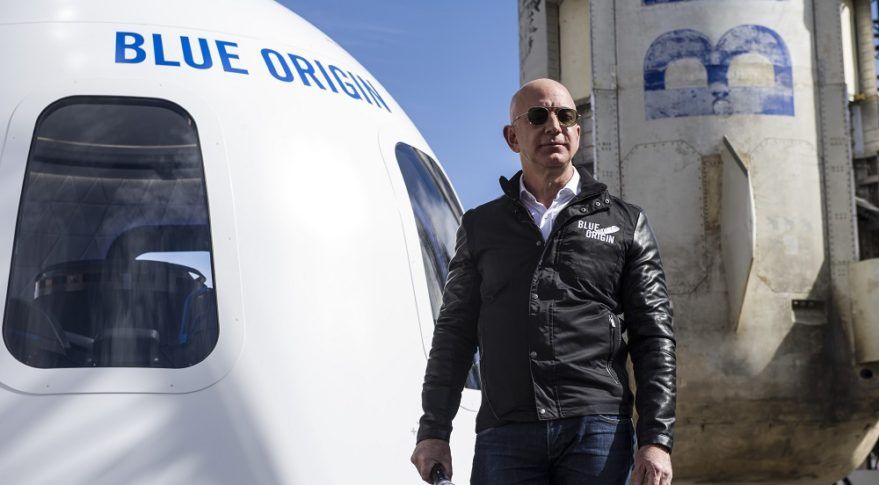
Jeff Bezos’ Blue Origin Moves Closer To Suborbital Passenger Flights
Article from CBS News April 14, 2021 (wsgw.com)
• On April 14th, Jeff Bezos’ Blue Origin took another step toward sending passengers into space with the launch of the fifteenth unpiloted New Shepard rocket in six years carrying an unmanned capsule on a suborbital test flight. Using live ‘astronaut stand-ins’ before takeoff and after landing to rehearse boarding and egress procedures, launch commentator Ariane Cornell said, “We’re getting very close to sending people up to space and back.” The stand-ins tested their communications gear and reviewed launch procedures before exiting to clear the pad for flight.
• Wednesday’s flight began at 12:51 p.m. ET when the New Shepard rocket’s hydrogen-fueled BE-3 engine launched from the pad at Blue Origin’s remote Van Horn, Texas, flight test facility. The stubby rocket quickly climbed away from Launch Site One, steadily accelerating to reach a maximum velocity of 2,247 mph before releasing the empty crew capsule about two minutes and 40 seconds after liftoff. The capsule then soared to an altitude of 66 miles, well above the 50-mile-high lower “boundary” of space, before beginning the long plunge back to Earth.
• The New Shepard booster homed in on its landing pad, restarting its engine and deploying four short landing legs before settling to an on-target touchdown. Inside the separated capsule, an instrumented test dummy dubbed ‘Mannequin Skywalker’ experienced three to five minutes of microgravity before atmospheric deceleration forces set in. The capsule floated to a relatively gentle landing a short distance away, slowed by three large parachutes.
• The New Shepard system is designed to carry space tourists, government and civilian researchers and a variety of payloads to altitudes just above the discernible atmosphere. Blue Origin has not yet announced when it plans its first launch with passengers on board or how much tickets might cost. But the New Shepard capsule will afford six passengers at a time several minutes of weightlessness and an out-of-this-world view through six large windows.
• NASA, the Air Force and the Federal Aviation Administration consider 50 miles to be the dividing line between space and the discernible atmosphere, while the international Fédération Aéronautique Internationale puts the threshold at 100 kilometers, or 62 miles. The New Shepard capsule routinely exceeds both of those standards.
• New Shepard is a strictly suborbital rocket and spacecraft that is not capable of achieving the velocities required to reach orbit. It will compete with Richard Branson’s Virgin Galactic suborbital spaceplane for commercial passengers and payloads. However, Blue Origin is developing orbit-class New Glenn rockets that will use a powerful new company-designed engine to help boost large satellites into orbit. The company has built a huge rocket factory just outside the Kennedy Space Center in Florida to manufacture the rockets and is developing a launch complex at the nearby Cape Canaveral Space Force Station.
• The company also is leading a team, one of three, designing a moon lander to carry astronauts to and from the lunar surface in NASA’s Artemis program. NASA is expected to award contracts to one or possibly two teams over the next few weeks.

Taking another step toward sending passengers into space, Jeff Bezos’ Blue Origin

launched an unpiloted New Shepard capsule on a suborbital test flight Wednesday, using astronaut stand-ins before takeoff and after landing to rehearse boarding and egress procedures.
The company has not yet announced when it plans its first launch with passengers on board or how much tickets might cost. But after 15 unpiloted test flights, the system appears to be on the verge of commercial operations, giving six passengers at a time a few minutes of weightlessness and an out-of-this-world view.

“We’re getting very close to sending people up to space and back,” said launch

commentator Ariane Cornell.
To help pave the way, company personnel walked up the launch gantry before liftoff and strapped in aboard the New Shepard capsule just as paying customers will do for an actual flight. The stand-ins tested their communications gear and reviewed launch procedures before exiting to clear the pad for flight.

Wednesday’s flight began at 12:51 p.m. ET when the New Shepard rocket’s hydrogen-fueled BE-3 engine ignited with a rush of flaming exhaust at Blue Origin’s remote Van Horn, Texas, flight test facility.
The stubby rocket quickly climbed away from Launch Site One, steadily accelerating as it consumed propellants and lost weight, reaching a maximum velocity of 2,247 mph before releasing the crew capsule about two minutes and 40 seconds after liftoff.
The capsule then soared to an altitude of 66 miles (348,753 feet), well above the 50-mile-high lower “boundary” of space, before beginning the long plunge back to Earth. Inside, an instrumented test dummy — Mannequin Skywalker — experienced three to five minutes of microgravity before atmospheric deceleration forces set in.
The New Shepard booster, meanwhile, homed in on its landing pad, restarting its engine and deploying four short landing legs before settling to an on-target touchdown. The capsule floated to a relatively gentle landing a short distance away, slowed as usual by three large parachutes.
FAIR USE NOTICE: This page contains copyrighted material the use of which has not been specifically authorized by the copyright owner. ExoNews.org distributes this material for the purpose of news reporting, educational research, comment and criticism, constituting Fair Use under 17 U.S.C § 107. Please contact the Editor at ExoNews with any copyright issue.
‘Mannequin Skywalker’, Ariane Cornell, BE-3 engine, Blue Origin, Jeff Bezos, NASA’s Artemis program, New Glenn rockets, New Shepard rocket, Richard Branson’s Virgin Galactic, Van Horn Texas flight test facility